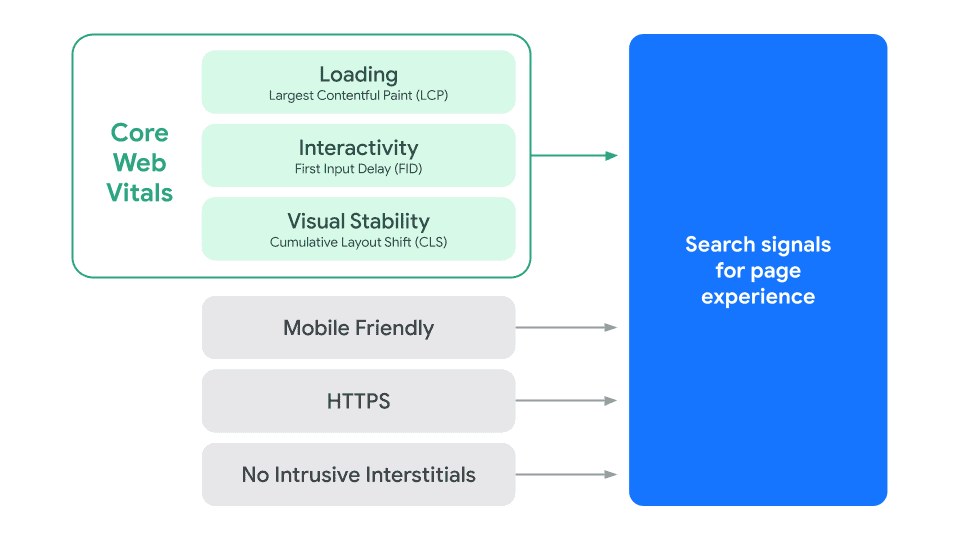Chapter 1: The Page Experience Update
Introducing the Page Experience Update
On June 15, 2021, Google rolled out the Page Experience Update, a search algorithm favoring pages that offer great user experience.
According to Google, the Page Experience Update includes a set of essential signals for delivering a good user experience.
Core Web Vitals (CWV)
Core Web Vitals are metrics that measure real-world user experience for loading performance, interactivity, and visual stability of the page. We will talk a lot about CWV since they are the main topic of this guide.
Mobile-friendliness
Ever since Google transitioned to Mobile-First Indexing, optimizing for mobile has become one of the most critical tasks for website developers and SEOs. With the Page Experience Update, having mobile-friendly pages became a requisite to rank well in Google.
You can check whether your pages are mobile-friendly with the Mobile-Friendly Test tool or the Mobile Usability report in Google Search Console.
HTTPS serving
Securing your pages with HTTPS is not only a good practice for SEO but a must to protect the data integrity of your website and your users’ personal information.
Follow Google’s guide to check whether your website’s connection is secure.
No intrusive interstitials
Avoid intrusive pop-ups that make content less accessible. Google considers intrusive interstitials those pop-ups that cover the main content or request user actions to access the main content.
Exceptions can be made for interstitials for legal obligations (e.g., cookie notices), login dialogs for publicly indexable content (e.g., content that is behind a paywall), and feasibly dismissable banners that don’t take too much space (e.g., app install banners).
For more on this topic, follow Google’s best practices to avoid intrusive interstitials.

Source: Google.
In this guide, we will focus on measuring and optimizing Core Web Vitals for SEO. However, before getting into the details of CWV, there are a few things to know about the Page Experience Update.
Page experience is one of many ranking factors
Google uses hundreds of ranking factors to determine the best pages to show in response to a search query. The Page Experience Update introduces a new ranking signal that is just one of many.
For example, page experience won’t override great content as pages with the best information will be the priority for Google’s algorithms. It means that delivering an excellent page experience by itself won’t solve your website’s ranking problems in search.
Google has also implied that page experience is a light ranking factor. It may be more important in scenarios when Google considers multiple pages to have similar content quality for a search query.
The page experience signal includes sub-signals
The page experience signal combines multiple sub-signals. As explained above, those sub-signals are:
- Core Web Vitals
- Mobile-friendliness
- Safe-browsing
- HTTPS serving
- No intrusive interstitials
Some of the sub-signals part of the larger Page Experience signal already were ranking factors. For example, mobile-friendliness has been a ranking factor since 2015.
We don’t know the weight of each sub-signal
Although there have been some attempts to estimate the weight of each sub-signal, Google is not disclosing it.
Core Web Vitals is not a binary sub-signal
A page does not need to have a Good score for all CWV to get ranking benefits. That’s because Core Web Vitals are not a binary ranking signal. They work more like a “gradient” ranking factor. The better a page is on a scale from Good to Poor, the bigger the ranking boost.
There is no benefit in over-optimizing Core Web Vitals
The above entails no benefit to over-optimizing a page once it has already reached the Good threshold for each CWV. Thus, don’t obsess trying to score higher to rank better!
Google uses Core Web Vitals for both mobile and desktop search
In case you didn’t know, Google also factors in CWV data for desktop search. Therefore, optimizing for desktop devices also matters!
Google may use Core Web Vitals data from noindex and blocked pages
Google has said they may or may not use Core Web Vitals data from deindexed and blocked pages as part of the Page Experience Update. For example, if people land on a page with good Core Web Vitals but subsequently go to other pages with poor page experience, it might affect the standing of the page or site.
Thus, optimizing critical pages on your website that may not even be indexed might end up benefiting your site in search.
Page experience will continue to evolve
Google said that they intend to update the page experience signals on an annual basis. Therefore, we should expect Google to remove, add, or reassess the strength of each sub-signal over time.
